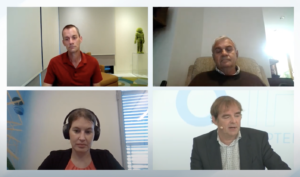How Human Connection Drives the Scientific Process
Khari Douglas

A somewhat surprising theme emerged during the “Scientific Vocation Revisited – Can Future Discoveries be Made by Artificial Intelligence?” session at the 8th Heidelberg Laureate Forum (HLF). The session featured panelists Jeffrey A. Dean (ACM Prize in Computing, Google Research), Harry Collins (Cardiff University), and Dafna Shahaf (The Hebrew University of Jerusalem); while they did discuss the potential impact of AI systems on the process of scientific discovery, they also kept reiterating the importance of human collaboration to making scientific advancements; particularly collaborations that occur face-to-face.
To open the session, moderator Volker Stollorz (Science Media Center Germany) asked Jeffrey Dean why private industry, such as Google and OpenAI, has been able to make such substantial breakthroughs in AI and machine learning. Stollorz cited DeepMind’s Alphafolds, which can predict the shape a protein will fold into based on its amino acid sequence, as one such example. Dean replied that many of these discoveries happen in private companies because they are capable of bringing together many people with diverse expertise, which is necessary to solve these kinds of complex problems.
Following Dean, Harry Collins, a sociologist of science, discussed the time he spent embedded in a team of scientists working on detecting gravitational waves. Collins argued that this group succeeded in detecting gravitational waves after years of research because of the trust and relationships developed during small group meetings. He said that to emulate this kind of science would require communicative computer systems that are able to recognize trust and moral values. Collins hopes to convince the scientific community not to abandon face to face conferences – in a 2020 article from Physics World, Collins and co-authors Bill Barnes and Riccardo Sapienza write: “The aspects that make science special are all developed through face-to-face socialization and it doesn’t seem to happen naturally over the Internet.”
Next, Dafna Shahaf discussed the role analogy plays in innovation; for example, the NASA radiator that was inspired by origami or the Odon childbirth device, which was created by an Argentinian car mechanic, who came up with the idea after watching a YouTube video on how to remove a loose cork from a bottle. These examples highlight the importance of sharing ideas between people to drive innovation, and many times these ideas are encountered by pure chance. Shahaf argued that we can accelerate innovation by teaching AI how to discover solutions by using analogy to find patterns, and she has done research in this space.
During the Q&A session, the panelists were asked how they would better align the publication and conference incentive system to better enable scientific advancement if they had magical powers. Shahaf said that, unfortunately, the conference system is broken, especially in very popular areas like machine learning, which gets thousands of submissions for major conferences. In her dream world, Shahaf said she would limit every researcher to a certain amount of submission “tokens” for their lifetime, so that you could only submit what you really thought was your best work. An interesting, though probably unworkable idea. Shahaf’s more serious suggestion was for researchers to submit to something like arXiv, after which conferences would compete to give papers their stamp of approval.
Dean said he agrees that we need to encourage more long-term research and that conferences are currently set up to reward incremental improvements in what we know how to do right now, rather than research that does something totally new. He argued we need to enable more innovative research, and that fewer, but longer-term papers are more useful than incremental innovations. Dean cited the ACM HOTNETS workshop as an example of a computing-centered workshop that focuses on blue-sky ideas. Shahaf agreed with Dean and cited the Innovative Ideas in Data Science (IID) workshop, which she co-organized, as another example.
While there were more technical discussions of emerging techniques that could allow AI to help make scientific discoveries, ironically, the major theme of the session seemed to really be the importance of human collaboration to the scientific process. You can watch the full video of this session on the HLF Youtube channel.
The post How Human Connection Drives the Scientific Process originally appeared on the HLFF SciLogs blog.